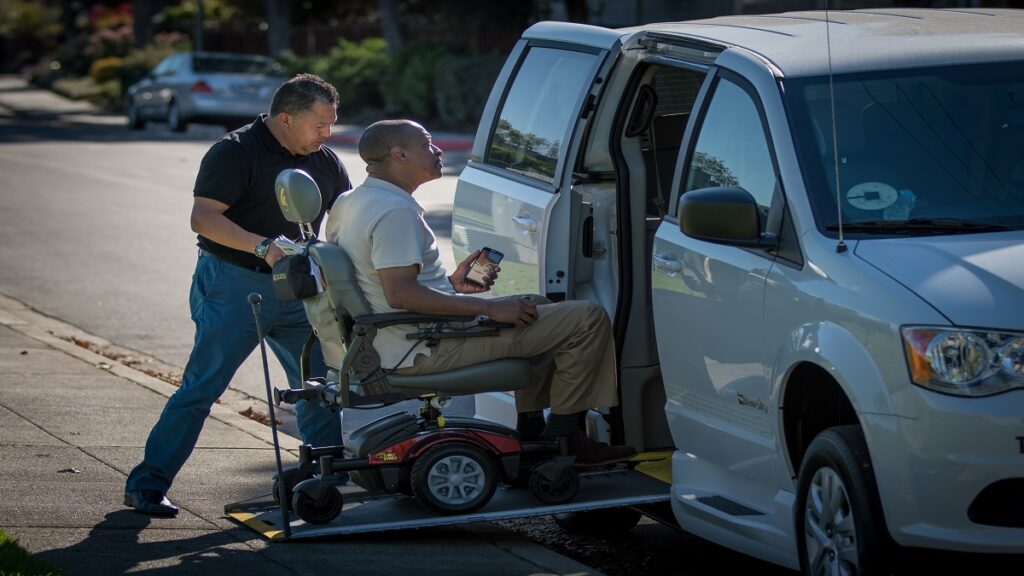If you need to transport a wheelchair, the easiest way is to use a wheelchair accessible taxi. These taxis are designed to provide comfortable and safe transportation for individuals using wheelchairs. They are equipped with wider doors and ramps to make entering and exiting the vehicle much easier, as well as plenty of room inside for the wheelchair user and any companions. Wheelchair accessible taxis also offer more maneuverability and reliability than other transportation options, ensuring that you reach your destination quickly and safely.
Using a Wheelchair-Accessible Vehicle
When it comes to transporting a wheelchair, a wheelchair accessible vehicle is your best friend. These specialized vehicles are designed to provide a safe and comfortable mode of transportation for wheelchair users. With wider doors and ramps, they make entering and exiting the vehicle a breeze. No more struggling with narrow doorways or awkward maneuvers.
To use a wheelchair-accessible vehicle, all you need to do is book a wheelchair taxi service. Many cities now offer these services, making it easy to get around without any hassle. Simply call or go online to make a wheelchair taxi booking, and the vehicle will be there to pick you up at the specified time.
One of the greatest benefits of using a wheelchair-accessible vehicle is the added space it offers. There is plenty of room inside for the wheelchair user and any companions, ensuring a comfortable journey. These vehicles also provide greater maneuverability and reliability compared to other transportation options. This means you can reach your destination quickly and safely.
So, when it comes to transporting a wheelchair, a wheelchair accessible vehicle is the easiest and most convenient option. Just remember to book a wheelchair taxi service in advance, and enjoy a stress-free ride to your destination.
Portable Wheelchair Ramps for Accessibility
Portable wheelchair ramps are essential for ensuring accessibility for wheelchair users in various locations. These ramps are lightweight, easy to carry, and can be quickly set up wherever they are needed. Whether you are navigating steps, curbs, or uneven terrain, portable ramps provide a practical solution to overcome these obstacles.
One of the main advantages of portable wheelchair ramps is their versatility. They can be used with any type of wheelchair and can accommodate different weights and sizes. This makes them ideal for individuals who frequently use a wheelchair taxi service or have to make wheelchair taxi bookings.
Another benefit of portable ramps is their convenience. They can be easily folded and stored in the trunk of a car or carried in a wheelchair-accessible vehicle. This allows wheelchair users to have their ramp readily available whenever they need it, ensuring they can access any location without difficulty.
When using portable ramps, it is important to ensure proper installation and stability. Look for ramps with anti-slip surfaces and secure attachment mechanisms to prevent accidents or injuries. It is also crucial to follow the manufacturer’s guidelines for weight limits and usage recommendations.
Wheelchair Tie-Down Systems for Safety
When it comes to transporting a wheelchair, safety is of utmost importance. That’s where wheelchair tie-down systems come into play. These systems are specifically designed to securely fasten wheelchairs in vehicles, preventing any movement during transportation. This ensures that wheelchair users are safe and protected throughout the journey.
Wheelchair tie-down systems typically consist of straps and anchors that are attached to the floor of the vehicle. These straps are then secured to the frame or wheels of the wheelchair, creating a stable and secure connection. This not only prevents the wheelchair from shifting during transit but also provides peace of mind to the wheelchair user.
Using a wheelchair tie-down system is essential, especially when using a wheelchair-accessible vehicle or a wheelchair taxi service. When making a wheelchair taxi booking, it is important to inquire about the availability of tie-down systems in the vehicles. This way, you can ensure that your wheelchair will be properly secured during the ride.
Wheelchair tie-down systems not only enhance safety but also contribute to a comfortable and stress-free travel experience. By eliminating any movement or shifting of the wheelchair, these systems provide a smooth and stable ride. So, next time you need to transport a wheelchair, make sure to utilize a wheelchair tie-down system for enhanced safety and peace of mind.
Foldable and Compact Wheelchair Models
Foldable and compact wheelchair models are a game-changer when it comes to wheelchair transportation. These innovative designs are perfect for individuals who need a wheelchair but also value convenience and portability.
The great thing about foldable and compact wheelchair models is that they can easily be folded or disassembled for easy storage and transport. This means you can easily fit them in the trunk of a car or take them on public transportation without any hassle. No more struggling to find a wheelchair-accessible vehicle or worrying about limited space.
But don’t let their compact size fool you, these wheelchairs are still just as sturdy and comfortable as traditional models. They are designed with durability and functionality in mind, so you can trust that they will provide a smooth and comfortable ride.
Additionally, foldable and compact wheelchairs are often made with lightweight materials, making them easier to maneuver and navigate through tight spaces. Whether you are exploring a busy city or maneuvering through narrow doorways, these wheelchairs will make your life much easier.
Assisted Transport Services for Wheelchair Users
Assisted transport services play a crucial role in ensuring that wheelchair users have access to reliable and convenient transportation options. These services are designed to cater specifically to the needs of wheelchair users, providing a safe and comfortable journey from point A to point B.
Assisted transport services for wheelchair users can vary depending on the location, but they often include wheelchair accessible taxi, shuttle buses, or paratransit services. These services are equipped with the necessary features to accommodate wheelchairs, such as ramps, lifts, and secure tie-down systems.
One of the main benefits of using assisted transport services is the peace of mind it offers. With trained and experienced drivers, wheelchair users can feel confident that they will receive assistance with entering and exiting the vehicle, as well as securing their wheelchair safely during the journey.
Another advantage of assisted transport services is their flexibility and convenience. They can be easily booked in advance, ensuring that wheelchair users have a reliable mode of transportation whenever they need it. This is particularly helpful for individuals who have appointments or need to travel to specific destinations regularly.
Furthermore, assisted transport services often have designated pick-up and drop-off points that are accessible for wheelchair users. This eliminates the need to navigate through crowded areas or inaccessible sidewalks, providing a smoother and more efficient travel experience.
Overall, assisted transport services for wheelchair users are an essential resource that promotes inclusivity and independence. They provide a convenient and reliable transportation solution, allowing wheelchair users to navigate their daily lives with ease. Whether it’s for medical appointments, social outings, or everyday errands, these services ensure that wheelchair users can reach their destinations safely and efficiently.

Accessible Public Transportation Options
For individuals using wheelchairs, having accessible public transportation options is crucial to maintain independence and mobility. Fortunately, many cities now offer a variety of accessible public transportation options to accommodate wheelchair users.
One common option is wheelchair-accessible buses. Inside, there are designated spaces for wheelchair users to securely position themselves during the ride. These buses are typically designed to be spacious and comfortable, ensuring a smooth journey for wheelchair users.
Another accessible public transportation option is accessible trains or trams. These modes of transportation often have designated spaces for wheelchair users and offer ramps or lifts for boarding and exiting. In addition, some trains have designated wheelchair-accessible compartments with accessible amenities, such as buttons for requesting assistance.
Many cities also offer paratransit services, which are specifically designed for individuals with disabilities. These services provide door-to-door transportation, accommodating individual needs and preferences. Paratransit services often require advance booking, but they provide a reliable and convenient option for wheelchair users who may have specific transportation needs.
Overall, having accessible public transportation options is vital for wheelchair users to be able to navigate their communities. By providing reliable and convenient transportation, these options ensure that wheelchair users can access important destinations, such as medical facilities, educational institutions, and social events, with ease.
Planning Routes for Wheelchair Accessibility
Planning routes for wheelchair accessibility is essential for ensuring a smooth and hassle-free journey for wheelchair users. When traveling to new or unfamiliar locations, it’s important to consider the accessibility of the route and the potential obstacles that may be encountered along the way.
Start by researching the destination and identifying the most accessible routes. Look for sidewalks with curb ramps, wheelchair-accessible public transportation options, and locations that have designated accessible parking spaces. Online mapping tools can be a great resource for finding accessible routes and identifying any potential barriers.
Additionally, it’s important to consider the time of day and the potential crowds or traffic that may impact accessibility. Avoid peak travel times if possible, as crowded areas can make navigation more difficult.
Another helpful tip is to reach out to local organizations or advocacy groups that specialize in accessibility. They may have valuable insights and recommendations for accessible routes or alternative transportation options.
Finally, don’t be afraid to ask for assistance when needed. Many cities have accessible travel information hotlines or services that can provide guidance and support in planning accessible routes.
By taking the time to plan routes for wheelchair accessibility, wheelchair users can ensure a safe and stress-free travel experience. Whether it’s for daily commutes, social outings, or traveling to new destinations, careful planning can make all the difference in creating an inclusive and accessible journey.
Maintaining Wheelchair Safety during Travel
Maintaining wheelchair safety during travel is of utmost importance to ensure a smooth and secure journey for wheelchair users. Several key steps can be taken to ensure wheelchair safety is prioritized throughout the entire travel experience.
First and foremost, it is crucial to properly secure the wheelchair in a wheelchair accessible vehicle or any other transportation mode. Utilize wheelchair tie-down systems to firmly fasten the wheelchair to prevent any movement or shifting during transit. These systems provide peace of mind and ensure the safety of the wheelchair user throughout the journey.
Additionally, it is essential to check the condition of the wheelchair before traveling. Inspect the wheels, brakes, and any other components to ensure they are in proper working order. Address any maintenance issues or concerns before embarking on the trip to avoid any potential safety hazards.
When using portable ramps, make sure they are securely set up and stable to provide a safe transition between surfaces. Always follow the manufacturer’s guidelines for weight limits and usage recommendations to prevent accidents or injuries.
Finally, when traveling on public transportation or navigating through crowded areas, remain vigilant and aware of the surroundings. Be mindful of obstacles, uneven surfaces, and potential hazards that may affect wheelchair safety.
By following these tips and prioritizing wheelchair safety during travel, wheelchair users can enjoy a worry-free journey and confidently navigate their daily lives with ease.

